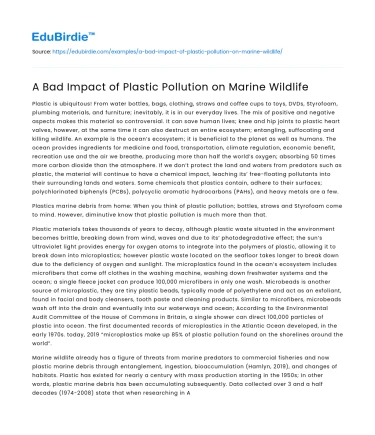Plastic is ubiquitous! From water bottles, bags, clothing, straws and coffee cups to toys, DVDs, Styrofoam, plumbing materials, and furniture; inevitably, it is in our everyday lives. The mix of positive and negative aspects makes this material so controversial. It can save human lives; knee and hip joints to plastic heart valves, however, at the same time it can also destruct an entire ecosystem; entangling, suffocating and killing wildlife. An example is the ocean’s ecosystem; it is beneficial to the planet as well as humans. The ocean provides ingredients for medicine and food, transportation, climate regulation, economic benefit, recreation use and the air we breathe, producing more than half the world’s oxygen; absorbing 50 times more carbon dioxide than the atmosphere. If we don’t protect the land and waters from predators such as plastic, the material will continue to have a chemical impact, leaching its’ free-floating pollutants into their surrounding lands and waters. Some chemicals that plastics contain, adhere to their surfaces; polychlorinated biphenyls (PCBs), polycyclic aromatic hydrocarbons (PAHs), and heavy metals are a few.
Plastics marine debris from home: When you think of plastic pollution; bottles, straws and Styrofoam come to mind. However, diminutive know that plastic pollution is much more than that.
Save your time!
We can take care of your essay
- Proper editing and formatting
- Free revision, title page, and bibliography
- Flexible prices and money-back guarantee
Plastic materials takes thousands of years to decay, although plastic waste situated in the environment becomes brittle, breaking down from wind, waves and due to its’ photodegradative effect; the sun’s Ultraviolet light provides energy for oxygen atoms to integrate into the polymers of plastic, allowing it to break down into microplastics; however plastic waste located on the seafloor takes longer to break down due to the deficiency of oxygen and sunlight. The microplastics found in the ocean’s ecosystem includes microfibers that come off clothes in the washing machine, washing down freshwater systems and the ocean; a single fleece jacket can produce 100,000 microfibers in only one wash. Microbeads is another source of microplastic, they are tiny plastic beads, typically made of polyethylene and act as an exfoliant, found in facial and body cleansers, tooth paste and cleaning products. Similar to microfibers, microbeads wash off into the drain and eventually into our waterways and ocean; According to the Environmental Audit Committee of the House of Commons in Britain, a single shower can direct 100,000 particles of plastic into ocean. The first documented records of microplastics in the Atlantic Ocean developed, in the early 1970s. today, 2019 “microplastics make up 85% of plastic pollution found on the shorelines around the world”.
Marine wildlife already has a figure of threats from marine predators to commercial fisheries and now plastic marine debris through entanglement, ingestion, bioaccumulation (Hamlyn, 2019), and changes of habitats. Plastic has existed for nearly a century with mass production starting in the 1950s; In other words, plastic marine debris has been accumulating subsequently. Data collected over 3 and a half decades (1974-2008) state that when researching in Australian waters, at least 77 marine wildlife species were found to be impacted by plastic through entanglement or ingestion. whereas at the present time plastic marine debris affects more than 700 species worldwide.
Sarah Hamlyn a biologist experienced that in Florida keys, plastic debris (broken down pieces of polystyrene, food wrappers, plastic bottles and microplastic) would often become trapped and entangled with other plastic debris such as fishing line, rope (polyethylene or nylon line for traps -both plastic polymers) buckets and polystyrene. Due to the ocean’s currents, these large and small entangled bits of plastic flow towards the ocean’s gyres, on the way collecting more plastic debris and entangling wildlife on its way to its deemed destination. In the ocean there are 5 major gyres, also recognized as the ocean trash vortexes. The Great Pacific Garbage Patch is a gyre that contains 16 times more waste than before, covering a 1.6 million-square-kilometer area; virtually the same size as Queensland. Entanglement of marine creatures can lead to abnormal shell development, starvation and drowning. Helena Ivancic provided an example of common entanglement; often associated with seals. ‘Plastic rings from soft-drink or alcohol packaging can become stuck around animals’ necks, restricting blood flow to the animal, causing serious injury’.
Plastic swallowed by animals does not need to be large in quantity to cause serious damage. plastic marine debris such as bags and Microplastics, become ‘food’ in the eyes of marine wildlife; to them looking and tasting like food .Yet there Is a huge down fall to the food chain’s latest addition, animals ingesting plastic’s often leads to cases of starvation (Hamlyn, 2019); plastics accumulate in the stomachs of animals, preventing them from getting enough nutrients (Ivancic, 2019) and may cause punctured organs and obstruction to the digestive tract, up until the animal can no longer truly consume genuine food an example by Hamlyn, states necropsy had showed animals (fish, mammals and birds) stomachs filled with plastic. Marine wildlife cannot tell the difference between artificial and authentic. Sea turtles frequently mistake plastic bags for jelly fish; sadly, the bags obstruct the turtle’s mouth and digestive system (Ivancic, 2019).






 Stuck on your essay?
Stuck on your essay?

